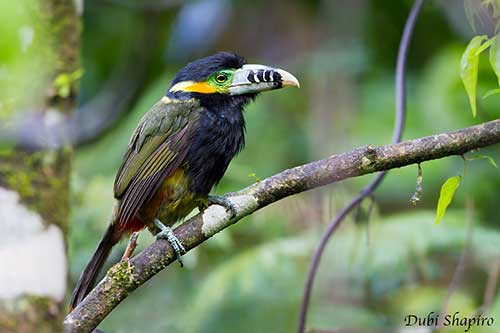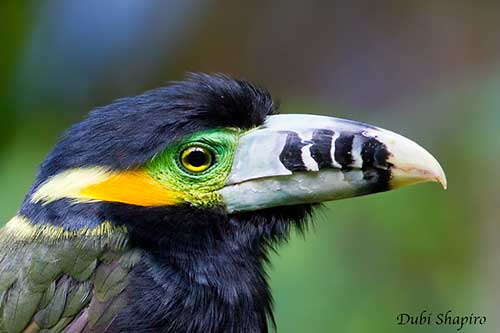
Fr : Toucanet à bec tacheté
Ang : Spot-billed Toucanet
All : Fleckenarassari
Esp : Tucanete Piquimaculado
Ita : Tucanetto beccomacchiato
Nd : Vleksnavelpepervreter
Sd : fläcknäbbad tukanett
Photographers:
William Price
PBase-tereksandpiper & Flickr William Price
Dubi Shapiro
Dubi Shapiro Photo Galleries & Dubi Shapiro's Pictures on IBC
Text by Nicole Bouglouan
Sources :
HANDBOOK OF THE BIRDS OF THE WORLD Vol. 7 by Josep del Hoyo-Andrew Elliott-Jordi Sargatal – Lynx Edicions – ISBN: 8487334377
Toucans, Barbets, and Honeyguides: Ramphastidae, Capitonidae and Indicatoridae par Lester Short,Jennifer F. M. Horne – Editeur: OUP Oxford, 2001 – ISBN: 0198546661, 9780198546665
Neotropical Birds – Cornell Lab of Ornithology
Spot-billed Toucanet
Selenidera maculirostris
Piciformes Order – Ramphastidae Family
INTRODUCTION:
The Spot-billed Toucanet occurs in the Atlantic Forest of SE Brazil and in adjacent E Paraguay and NE Argentina. It is among the smallest of the toucans. The genus Selenidera exhibits sexually dimorphic plumages and shows distinctive muscle features. They live in forest with well-developed middle-storey.
During the breeding season, their displays are accompanied by songs and various sounds. They feed primarily on fruits from several plant species, but insects and small vertebrates are also part of their diet.
The Spot-billed Toucanet is affected by destruction and fragmentation of forest. It is usually uncommon, but currently not globally threatened.
DESCRIPTION OF THE BIRD:
Biometrics:
Length: 33-37 cm
Weight: 137-193 g
The Spot-billed Toucanet adult male has green upperparts. Flight-feathers and uppertail are darker green with chestnut tips to central rectrices.
On the black underparts, we can see deep yellow markings on flanks. The thighs are rusty, whereas the undertail-coverts are red. The blackish undertail also shows chestnut tips to central rectrices.

The head is black with an orange-gold patch below and at rear of the eye, joining a narrow yellowish auricular patch. There is a narrow, pale yellow band between the nape and the upper back, like a collar.
The bill is curved with slightly hooked tip. It is pale greenish-yellow to ivory with brighter tip. The rounded central culmen is black. There are 3-5 vertical black stripes along the sides of the upper mandible, connecting at top with the black culmen, but the rearmost band does not connect. The lower mandible is mainly barred towards the tip, in front of the last band of the upper mandible.
The eyes are yellow with slit-like pupil, due to dark spots just before and behind the black pupil. The eyes are surrounded by broad, bare, pale blue, green or turquoise eyering.
Legs and feet are pale bluish-grey.
The female has chestnut head and the underparts are mostly cinnamon-rufous. Ear-tufts and flanks are cinnamon. She has shorter bill than male, and she may have slightly duller head pattern.
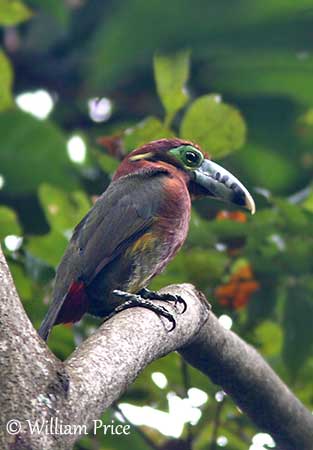
The immature has lax plumage with duller colours on bill. It lacks the narrow yellowish collar. The bill becomes marked at 8-9 weeks old. The eyering is grey-white and becomes blue at one month. The eyes are mostly brown to greenish-brown. They become yellow between 4 and 8 weeks of age.
RANGE:
The Spot-billed Toucanet is found in SE Brazil in the Atlantic Forest, and also in adjacent E Paraguay and NE Argentina.
HABITAT:
The Spot-billed Toucanet frequents dense middle-storey in forest, usually moist primary forest and adjacent advanced secondary growth, gallery forest and palm groves.
The species occurs from sea-level to 1,000/1,200 metres of elevation on mountain slopes.
CALLS AND SONGS: SOUNDS BY XENO-CANTO
In the Spot-billed Toucanet, male and female sing one at a time, although a pair may perform duets when the mates are not very close to each other.
The song is a short series of hollow, croaking notes “grrowk”, “ggaww” or “kgrooaw” lasting 4-8 seconds. The first notes are usually higher. Bill-tipping and bill-clicking can be heard too.
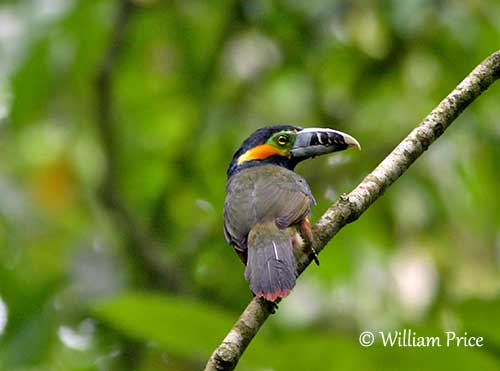
BEHAVIOUR IN THE WILD:
The Spot-billed Toucanet is primarily frugivorous, but it may occasionally feed on small vertebrates (lizards), eggs, and insects during the nesting period.
It forages in the dense middle-storey and undergrowth, and may sometimes come to the ground. It can be seen alone or in pairs, and also in small groups.
During the breeding season, the Spot-billed Toucanet is territorial and monogamous. During the courtship period, courtship-feeding by male to female is common. It feeds the female with regurgitated fruits. Both mates also perform mutual preening.
While singing, the bird bows low. The head is raised high. The ear-tufts are flared. The bright-coloured flank patches are displayed too, while the red undertail-coverts are fluffed. The tail is cocked and then lowered, while the bird is singing. The movements are more or less in time with the notes.
The Spot-billed Toucanet probably moves sometimes according to the food resources. But these movements are poorly known.
The flight is more direct than in larger toucans, with faster wingbeats. This species does not perform aerial displays.
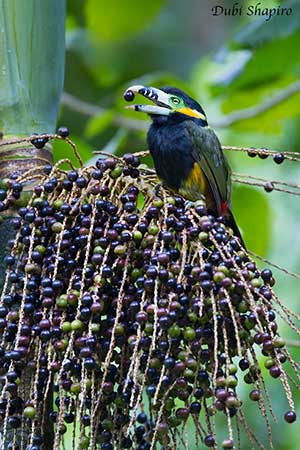
REPRODUCTION OF THIS SPECIES:
The breeding season occurs between December and June in N, and between October and January in S part of the range.
The Spot-billed Toucanet nests in cavity, usually an old woodpecker hole. However, they may also excavate their own nest hole in soft or well-rotted wood. The entrance is sometimes concealed by vegetation such as Bromeliad leaves.
From an observation of two nests, the entrance of a nesting cavity was between 2 and 7 metres above the ground. It was a vertical access tunnel and the nest was about one metre in depth inside the tree.
The female lays 2-3 white eggs. In captivity, the incubation lasts 15 days. Both adults are in the nest at night. The chicks are fed on fruits and dead mice and they develop slowly.
In the wild, the adults often perch on a branch in front of the nest entrance before entering the cavity. Both parents feed the chicks by regurgitation. Fruits from several plant species are included in the diet of the young birds.
In captivity, the young fledge 6-7 weeks after hatching, and they are still fed by the adults for some days more.
PROTECTION / THREATS / STATUS:
The Spot-billed Toucanet is present in several parks and reserves where the habitat is protected. However, the species is threatened by forest fragmentation and habitat destruction. The species is described as “uncommon” throughout the range.
The population size is unknown, but it is suspected to be declining locally. But currently, the Spot-billed Toucanet is evaluated as Least Concern.
